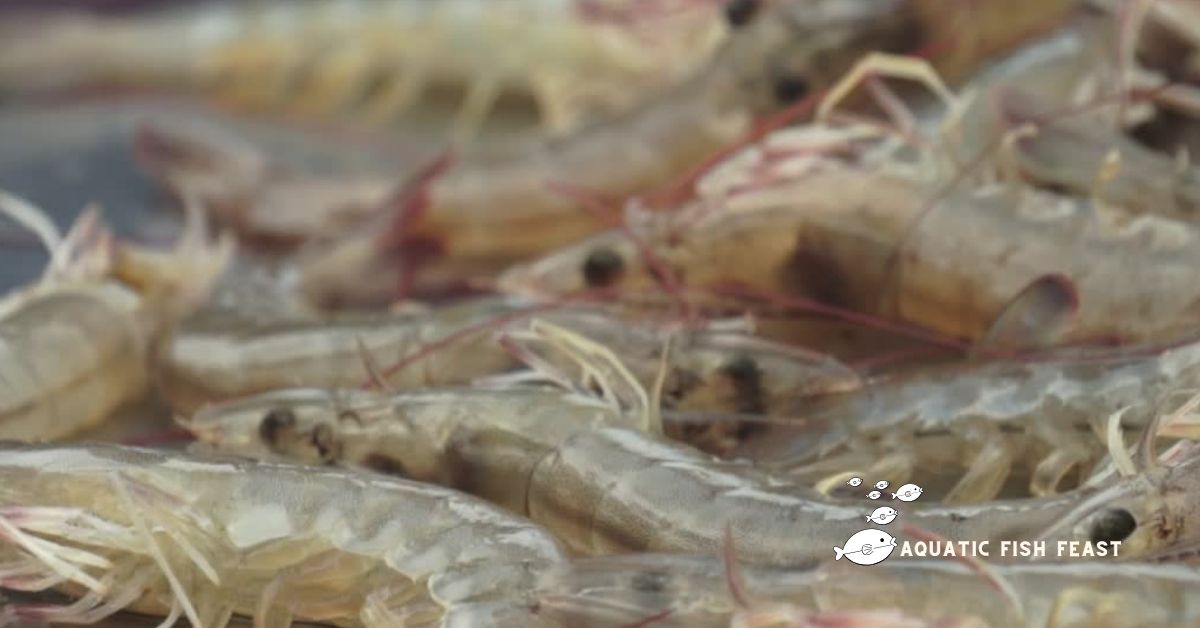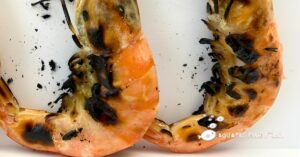Would you want to know if prawns are freshwater? I’ve seen prawns in fresh and salt water, but most are in freshwater, while shrimp are primarily found in salt water.
Most types of prawns like it when the water is warmer. In the Northern Hemisphere, however, many species live in colder water.
All crabs, including freshwater prawns, have a hard shell that they must shed occasionally to grow.
The process of losing the shell is called “molting,” most of the time, the animal gets bigger and heavier right after each molt. Because of these regular molts, growth happens in clear steps instead of all at once.
That’s not all, though; as you read on, I’ll teach you more about the subject.
Now, let’s get started.
Table of Contents
Are prawns freshwater?
To understand better weather prawns are freshwater spices or not, The fact is that most prawns are saltwater crustaceans which are require to survive in the saline water.
And from what I have known, the common saltwater prawns are these tiger, king, and shrimp types. They are found in most oceans, seas, estuaries, and mangroves.
Several prawn species may grow in freshwater. Bamboo, maroon, and Australian red claw crayfish are freshwater prawns.
Freshwater prawns are smaller than saltwater ones. They inhabit lakes, streams, and wetlands. Prawns are both saltwater and freshwater, however most depart in saltwater.
Like I said most prawns species are require to live in saltwater to sulvive. There are a small number of prawn species which are group as freshwater prawns.
But the vast majority live in saline ocean, coastal, or estuarine environments. The natural habitat of prawns depends on the individual species.
Both freshwater and saltwater environments can support prawn populations.
What are freshwater prawns called
In numerous regions of the globe, the freshwater prawn, also known as the freshwater shrimp, is a member of the freshwater crustacean family.
Most aquaculture endeavors have been focused on the native of southern Asia, Macrobrachium rosenbergii, also known as the Giant Malaysian Prawn.
Macrobrachium rosenbergii, a species of palaemonid freshwater prawn also referred to as the giant river prawn or giant freshwater prawn, holds significant commercial value.
This species inhabits tropical and subtropical regions spanning the Indo-Pacific, including Southeast Asia, Northern Australia, and India.
Can prawns grow in freshwater
Usually, fresh water is used to grow freshwater prawns from postlarvae to market size. M. rosenbergii can grow in water that is 3–4 ppt salty.
A very important thing to consider when choosing a spot is how reliable the water quality and amount are.
But, just like with hatchery water sources, it might be hard to say what the “ideal” water quality is for rearing places; a range of water qualities might work well in most cases.
The amount of calcium in the waters where the fish are raised is significant. It has been said that plants grow less quickly in hard water than in soft water.
Since the water has a total hardness of more than 150 mg/l (CaCO3), it is not suggested that river prawn farming be done there.
Freshwater prawns live in muddy water where they are native and spend most of their lives in murky river systems.
They go through four different stages in their life cycle: egg, larva, postlarva, and adult. Because prawns can’t handle cold weather, output in areas with milder weather has been limited.
Like other crabs, freshwater prawns have a tough shell that they must shed often to grow. For this to happen, you need to moult. Because of these regular moults, growth occurs in small steps instead of all at once.
How long do freshwater prawns live
Even though freshwater prawns can live for up to three years, you can start harvesting giant prawns as early as five months of age after they have reached maturity.
Considering that freshwater prawns are a tropical species, it is necessary for them to possess warm water in order to thrive.
Freshwater prawns are mostly found in muddy water where they are native and spend most of their lives in murky river systems.
They go through four different stages in their life cycle:
- Egg
- Larva
- Postlarva
- Adult
Because prawns can’t handle cold weather, output in areas with milder weather has been limited.
Like other crabs, freshwater prawns have a tough shell that they must shed often to grow. For this to happen, you need to moult. Because of these regular moults, growth occurs in small steps instead of all at once.
How fast do prawns grow
They’ll grow to be about the size of one grain of rice at three weeks of age and double that size when they’re around five weeks old.
Wild prawns typically live for 14-18 months, and females can have babies from about ten months of age. Farmed prawns are harvested at five to seven months of age.
Within four to five months, prawns approach a marketable size. Although the average harvest weight is 25-35 grams, male prawns have the potential to attain more excellent dimensions.
A prolonged period of culture may be necessary when increasing the livestock density.
However, Researchers have developed a new strain of prawn that grows 25% faster than other strains to feed people living alongside Asia’s great rivers.
The researchers combined three strains of giant freshwater prawns into one breeding stock and then developed the prawn families with the highest growth rate.
By shortening the production cycle of the giant freshwater prawn, researchers believe they can help provide more food for the 60 million people in the Mekong River Basin. The new strain of prawn is also likely to increase profits for many local farmers.
How many eggs do freshwater prawns lay
It has been shown that mature females may lay anywhere from 80,000 to 100,000 eggs during a single spawning, even though first spawns only produce 5,000 to 20,000 eggs per female. Until they hatch, the eggs stay linked to the mother’s belly.
Monsoon rains, salt intrusion, and temperature are some environmental factors that might cause activity peaks. Breeding season typically occurs in the summer in temperate regions.
Ovipositing setae, which are stiff hairs found at the base of the walking legs, direct the eggs extruded from the gonophores into the brood chamber within a few hours of mating.
The spermatozoa that cling to the outside of the mother’s body fertilize the eggs throughout this procedure.
In the brood chamber attached to the ovigerous setae, the eggs are retained and kept aerated by the active motions of the pleopods and swimmerets.
The females carry out the incubation period, which lasts around three weeks (with slight variation depending on temperature). In general, incubation works best at a temperature between 28 and 30 degrees Celsius.
A female may lay anywhere from 80,000 to 100,000 eggs at maturity in a single spawning. However, this number varies greatly depending on her size.
But initial broods—those that hatch in the first year of a bird’s life—typically only lay 5,000 to 20,000 eggs. As a general rule of thumb, one gramme of a healthy female may generally produce 500 to 1000 larvae.
What do freshwater prawns eat
Freshwater prawns have nutritional requirements similar to those of penaeid shrimp. However, the diets used in commercial prawn production usually contain less total protein and fishmeal than those used in penaeid culture.
This is due primarily to the lower biomass densities at which prawns are cultured, allowing natural foods to contribute more to their nutritional demands.
For example, in an extensive culture, freshwater prawns are stocked with 1 to 4 animals per square meter, and production levels of less than 500 kilograms per hectare year are achieved relying solely on ponds’ natural productivity.
In semi-intensive prawn production, animals are stocked at 4 to 20 per square meter with fertilization and a balanced feed ration applied—semi-intensive grow-out results in 500 to 5,000 kilograms per hectare year production rates.
Intensive culture refers to high-input production utilizing continuous aeration, rigorous water quality control, and nutritionally complete feed.
Under intensive culture conditions, production rates over 5,000 kilograms per hectare per year can be achieved.
A wide range of agricultural by-products of plant and animal origin can be included in prawn feeds—the composition of some commonly used ingredients.
The level of inclusion of individual ingredients depends upon factors such as anti-nutritional factors, cost, digestibility and nutrient composition.
Inclusion levels of some ingredients and their composition are given. Ongoing research for new and cheap ingredients focuses on plant-based ingredients.
Final thought
Now that we have established that prawns in fresh and salt water, but most are in freshwater, while shrimp are primarily found in salt water.
The freshwater prawn cultivation process consists of three stages: hatchery, nursery, and pond grow-out.
If you are thinking about launching a freshwater shrimp production business, skip, at least initially, the hatchery stage and maybe the nursery stage by buying young shrimp from a provider.
When the animals grow out of the pond and your output rises, you should start preparing to build an incubator and maybe a nursery.
There are few providers of young prawns, but as demand grows, more businesses focusing on producing and selling seed stock will soon be required.
Planning for a water supply, choosing a pond location, and building the pond are the first steps towards successfully growing prawns in ponds throughout the grow-out period.
Prestocking, juvenile stocking, feeding, and water quality management are all necessary steps in the production cycle till harvest.
Similar Post:




